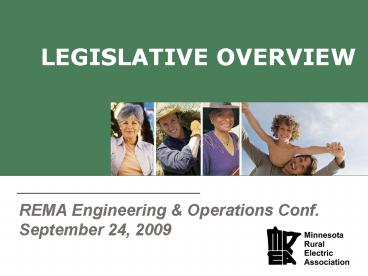LEGISLATIVE OVERVIEW - PowerPoint PPT Presentation
1 / 16
Title:
LEGISLATIVE OVERVIEW
Description:
The big budget deficit was a 'Bad News/Good News' situation for the electric ... Law and rule at www.revisor.leg.state.mn.us . PUC reviews IOU reports annually. ... – PowerPoint PPT presentation
Number of Views:55
Avg rating:3.0/5.0
Title: LEGISLATIVE OVERVIEW
1
LEGISLATIVE OVERVIEW
- REMA Engineering Operations Conf.
- September 24, 2009
2
2009 Legislative Session
- Focus was on the 6.4 billion budget deficit.
- The big budget deficit was a Bad News/Good News
situation for the electric industry. - Economic downturn hurts everyone.
- Budget crisis took up almost all of legislators
time and made them leery of doing anything that
would make the situation worse.
3
Carbon Legislation
- No serious carbon legislation was considered or
even introduced. - Willingness to let federal government deal with
the issue. - Energy committees focused mainly on spending the
federal stimulus funds. - Concern about jobs and cost are growing.
4
Good News on CIP
- Legislators and staff at the Office of Energy
Security (OES) are looking for ways to improve
CIP. - A proposal allowing utilities to bank
conservation credits passed - Working with co-ops and other utilities on ways
to meet the standards, including - Ways to include education programs and measure
their success - Re-assessing previous decision to not include
load management
5
Key Legislation
- Omnibus Energy Policy Bill
- Actually turned out pretty good for co-ops
- File standard contract for small wind projects
- Increase HVTL eminent domain appraisal fee
- Bank CIP savings in excess of 1.5 for 3-5 yrs
- Request OES to exceed 5 CIP for qualified solar
projects, up to 10 to meet demand - PUC OES annual report on transmission needed
for reliability - .
6
Key Legislation
- Avoided the worst proposals
- Establish 800 MW CBED carve out and market
rates - Establish feed-in tariffs for wind and solar
- Repeal all utility eminent domain exemptions
- Increase all utility property taxes and decrease
or eliminate exemptions - Allow cities to impose new kwh franchise fee
- Unfortunately, repeal of the nuclear plant
moratorium was defeated
7
Key Legislation
- Omnibus Energy Finance Bill
- Again, final outcome was pretty good, considering
the budget environment. - DNR add supplemental application fee to process
state water and land crossing license. - OES assess all energy utilities for energy
planning and conservation activities. - PCA establish greenhouse gas emissions reporting
system. - Create a Minnesota Green Enterprise Assistance
Project.
8
Key Legislation
- Federal Stimulus Bill
- Energy efficiency programs
- Weatherization 131.9 million
- Grants to local governments and school districts
- Renewable energy programs
- Rebates for small renewables 5.0 M
- Grants to local governments and school districts
- Commercial and industrial energy projects
9
Key Legislation
- Taxes
- Final tax bill was vetoed. However, despite
attempts to target utilities, none of them made
it into the final bill. - Proposals included an increase in the class rate
for utilities, removal of property tax
exemptions, elimination of sales tax exemption on
home heating, new franchise fees and city or
county taxes based on Kwh sales.
10
2010 Legislative Outlook
- Even year session, with bonding as the focus.
- Budget outlook still bleak.
- Because of size of State deficit, still worry
about carbon impact fee or electricity
surcharge - Or, as we saw in 2009, increase utility property
taxes and delete or restrict current utility
property and sales tax exemptions - Meeting renewable energy mandate oppose mini-RES
proposals
11
2010 Legislative Outlook
- Cap and Trade or Carbon Tax (or fee) remain a
concern. - Budget situation will make new revenue sources
attractive. - Outcome of federal efforts unclear. Strongest
proponents of Cap Trade are not likely to be
satisfied and will push for stronger state or
regional program. - Utilities will contribute 40 of the states GHG
reduction goal by 2025 - Renewable energy standard about 20
- Conservation programs about 20
12
2010 Legislative Outlook
- Governors Midwestern Greenhouse Gas Accord still
in play for 2010 - MN Climate Change Advisory Group report and
related issues coal and nuclear moratorium - CAPX 2020 Eminent domain exemptions will again
be challenged and new proposals are likely. - Grassroots support and involvement needed more
than ever.
13
PUC and SRSQ
- Co-ops under SRSQ law (MS 216B.029) states co-op
SRSQ standards should be as consistent as
possible with PUC rule, but not under PUC rule
(MR 7826) - Law and rule at www.revisor.leg.state.mn.us .
- PUC reviews IOU reports annually. Co-op boards
should be doing the same - NESC, IEEE, ANSI, OSHA/MDLI
- SAIDI, SAIFI, CAIDI
- Service quality standards calls and response,
disconnections, complaints, etc. Technical and
administrative feasibility.
14
PUC and SRSQ
- How high do you go toward unachievable
perfection? Are outage levels to be maintained
or steadily improved? - How best balance overall reliability with
corresponding cost? Develop prototype
reliability cost matrix. - Example of EPRI on SAIDI National SAIDI average
100 minutes top quartile 70 minutes. Goal
for 2009 - Xcel Metro West 117.2 Xcel Southeast
90.92 - Minnesota Power 119.31
- OTP Bemidji 48.25 OTP Fergus Falls 74.00
- IPL Winnebago 59.81 IPL Albert Lea 80.30
15
PUC and SRSQ
- Calculate outage data (both planned and
unplanned) using two methods and explain
difference Storm normalized using IEEE 2.5 Beta
method and non-storm normalized. - Begin power quality data collection, including
MAIFI Momentary Average Interruption Frequency
Index. - Begin generic proceeding for all electric
utilities on power voltage quality. - See www.puc.state.mn.us. Then Search Dockets.
Scroll down to Basic Search type in 09-343.
16
THE END -- THANK YOU
- Comments?
- Questions?
- Detailed 2009 MREA Legislative Report at
http//www.mrea.org/legislativecenter/downloads/20
09_MREA_Legislative_Summary.pdf.































